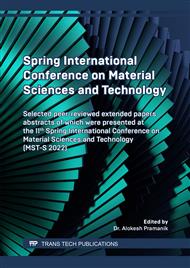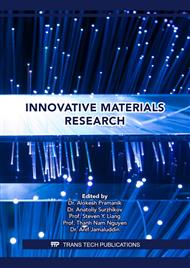[1]
Bideau, J., L. Viau, and A. Vioux, Ionogels, Ionic Liquid Based Hybrid Materials. Chemical Society reviews, 2011. 40: pp.907-25.
DOI: 10.1039/c0cs00059k
Google Scholar
[2]
Andrzejewska, E., A. Marcinkowska, and A. Zgrzeba, Ionogels – materials containing immobilized ionic liquids. Polimery -Warsaw-, 2017. 62: pp.344-352.
DOI: 10.14314/polimery.2017.344
Google Scholar
[3]
Adam J. Greer , J.J.a.C.H., Industrial Applications of Ionic Liquids. molecules, 2020. 25(5207): pp.1-31.
Google Scholar
[4]
Javed, F., et al., An approach to classification and hi-tech applications of room-temperature ionic liquids (RTILs): A review. Journal of Molecular Liquids, 2018. 271: pp.403-420.
DOI: 10.1016/j.molliq.2018.09.005
Google Scholar
[5]
Zawada Donato, K., et al., Recent Applications of Ionic Liquids in the Sol-Gel Process for Polymer–Silica Nanocomposites with Ionic Interfaces. Colloids and Interfaces, 2017. 1: p.5.
DOI: 10.3390/colloids1010005
Google Scholar
[6]
Singh, M.P., R.K. Singh, and S. Chandra, Ionic liquids confined in porous matrices: Physicochemical properties and applications. Progress in Materials Science, 2014. 64: pp.73-120.
DOI: 10.1016/j.pmatsci.2014.03.001
Google Scholar
[7]
Khodagholy, D., et al., Organic electrochemical transistor incorporating an ionogel as a solid state electrolyte for lactate sensing. Journal of Materials Chemistry, 2012. 22(10): pp.4440-4443.
DOI: 10.1039/c2jm15716k
Google Scholar
[8]
Sun, J., et al., A transparent, stretchable, stable, self-adhesive ionogel-based strain sensor for human motion monitoring. Journal of Materials Chemistry C, 2019. 7(36): pp.11244-11250.
DOI: 10.1039/c9tc03797g
Google Scholar
[9]
Li, T., et al., Mechanically Robust, Elastic, and Healable Ionogels for Highly Sensitive Ultra-Durable Ionic Skins. Advanced Materials, 2020. 32(32): p.2002706.
DOI: 10.1002/adma.202002706
Google Scholar
[10]
Lai, J., et al., Highly Stretchable, Fatigue-Resistant, Electrically Conductive, and Temperature-Tolerant Ionogels for High-Performance Flexible Sensors. ACS Applied Materials & Interfaces, 2019. 11(29): pp.26412-26420.
DOI: 10.1021/acsami.9b10146
Google Scholar
[11]
Khurana, S. and A. Chandra, Ion conducting polymer-silica hybrid ionogels obtained via non-aqueous sol-gel route. Solid State Ionics, 2019. 340: p.115027.
DOI: 10.1016/j.ssi.2019.115027
Google Scholar
[12]
Sert Çok, S., et al., Revealing the pore characteristics and physicochemical properties of silica ionogels based on different sol-gel drying strategies. Journal of Solid State Chemistry, 2019. 278: p.120877.
DOI: 10.1016/j.jssc.2019.07.038
Google Scholar
[13]
Tripathi, A.K., Ionic liquid–based solid electrolytes (ionogels) for application in rechargeable lithium battery. Materials Today Energy, 2021. 20: p.100643.
DOI: 10.1016/j.mtener.2021.100643
Google Scholar
[14]
Thapaliya, B.P., I. Popov, and S. Dai, Layer-by-Layer Assembly Strategy for Reinforcing the Mechanical Strength of an Ionogel Electrolyte without Affecting Ionic Conductivity. ACS Applied Energy Materials, 2020. 3(2): pp.1265-1270.
DOI: 10.1021/acsaem.9b01932
Google Scholar
[15]
Gupta, A.K., et al., Low density ionogels obtained by rapid gellification of tetraethyl orthosilane assisted by ionic liquids. Dalton Transactions, 2012. 41(20): pp.6263-6271.
DOI: 10.1039/c2dt30318c
Google Scholar
[16]
Tafur, J.P. and A.J. Fernández Romero, Electrical and spectroscopic characterization of PVdF-HFP and TFSI—ionic liquids-based gel polymer electrolyte membranes. Influence of ZnTf2 salt. Journal of Membrane Science, 2014. 469: pp.499-506.
DOI: 10.1016/j.memsci.2014.07.007
Google Scholar
[17]
Noor, N.A.M. and M.I.N. Isa, Investigation on transport and thermal studies of solid polymer electrolyte based on carboxymethyl cellulose doped ammonium thiocyanate for potential application in electrochemical devices. International Journal of Hydrogen Energy, 2019. 44(16): pp.8298-8306.
DOI: 10.1016/j.ijhydene.2019.02.062
Google Scholar
[18]
Dhatarwal, P., S. Choudhary, and R.J. Sengwa, Electrochemical performance of Li+-ion conducting solid polymer electrolytes based on PEO–PMMA blend matrix incorporated with various inorganic nanoparticles for the lithium ion batteries. Composites Communications, 2018. 10: pp.11-17.
DOI: 10.1016/j.coco.2018.05.004
Google Scholar
[19]
Aziz, S.B., et al., A Promising Polymer Blend Electrolytes Based on Chitosan: Methyl Cellulose for EDLC Application with High Specific Capacitance and Energy Density. Molecules, 2019. 24(13).
DOI: 10.3390/molecules24132503
Google Scholar



